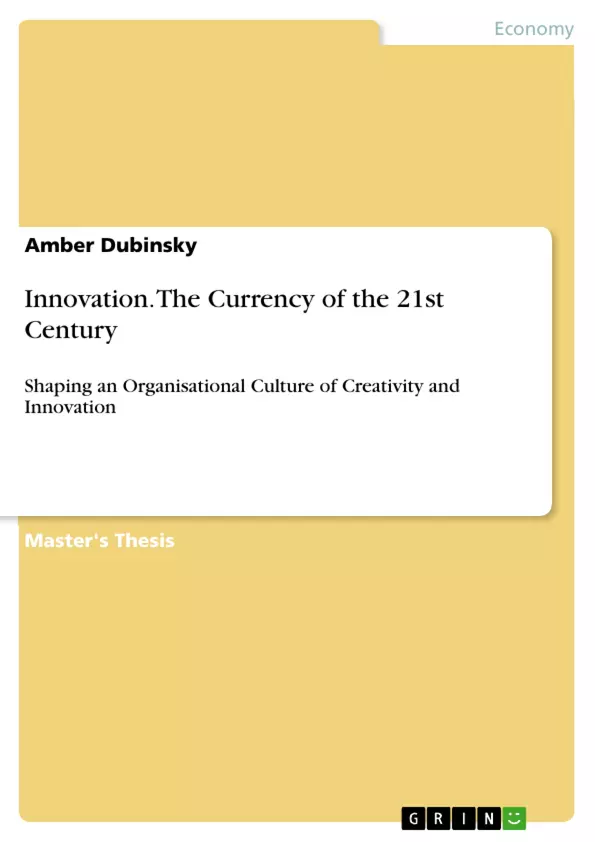This thesis aims at providing value to small and medium-sized enterprises (SME). In Switzerland these enterprises constitute 97% of all Swiss companies and employ 67% of the working population. These figures clearly demonstrate that SMEs are the backbone of the Swiss economy.
Although the type of companies studied varied considerably in size, the concrete measures surfaced in the research that stimulate creativity and innovation are mostly size irrelevant. The belief that large corporations’ ability to apply costly measures, would outplay SMEs proved to not necessarily hold true. This can be explained by the fact that organisational culture is predominantly about human interaction. It is about the people as they are the ones armed with great ideas.
This study further reveals that these creative thoughts and ideas are frequently developed in a friendly atmosphere where people from different divisions can come together and exchange ideas. Creative hunches often occur through informal exchanges where work and social interactions are encouraged in everyday life. Therefore, not only places for “doing” need to be provided, but places for “being” are equally important. This human-centric orientation must be further supported by employee empowerment, trust and the freedom to take actions on behalf of the company. These values have a powerful impact on individuals and make them engage by means of intrinsic motivation.
The synergy of these factors provides a lively melting pot where the communication culture promotes an honest exchange of opinions. This is considered as the most productive method in achieving great results. However, without the active role of management support, no such culture can be achieved. Impartially rewarding achievements, embracing uncertainty, allowing risk-taking and mistakes are prerequisites for innovation. Implementation of these factors may appear to be straightforward, however, it demands a high degree of letting go. These components must form an integral part of company strategies and are effective if they are not only clearly communicated throughout the entire workforce in a consistent manner, but also experienced and lived by employees in the daily operations and interactions. This clearly answers Drucker’s question - “how much of innovation is inspiration, how much is hard work?” - and shows the great degree of influence that is held by management support.
Inhaltsverzeichnis (Table of Contents)
- INTRODUCTION
- THE IMPORTANCE OF INNOVATION
- Innovation trends in world economics
- Swiss innovation support
- Innovation in corporations
- INITIAL SITUATION
- Innovation - the engine of change
- The drivers of innovation
- Organisational culture - a spiritual force
- The value of organisational culture on creativity and innovation
- PROBLEM DEFINITION
- Innovation · a buzzword
- Reasons for innovation failure
- The challenge of fragmented literature
- OBJECTIVES & RESEARCH QUESTIONS
- SCOPE OF THE STUDY
- DOCUMENT STRUCTURE
- THE IMPORTANCE OF INNOVATION
- METHODOLOGY
- EMPIRICAL DESIGN
- Research approach and methodology
- Objectivity and transparency
- Validity
- Reliability
- Strengths of the Empirical Design
- Generalisation and Limitations of the Empirical Design
- STRATEGIC SAMPLE
- The interviewees
- Limitations of the strategic sample
- Pre-Test
- CONDUCT OF INTERVIEWS
- INTERVIEW OUTLINE
- INTERVIEW ANALYSIS SCHEME
- Categories for Themes
- EMPIRICAL DESIGN
Zielsetzung und Themenschwerpunkte (Objectives and Key Themes)
The research aims to gain a deeper understanding of organisational cultures, particularly focusing on management support as a critical component for promoting creativity and innovation within companies. The study seeks to identify and analyze key factors that foster a culture conducive to creativity and innovation, ultimately providing practical recommendations for small and medium-sized enterprises (SMEs).
- The importance of innovation in the 21st century
- The impact of organisational culture on creativity and innovation
- Identifying key factors that foster a culture of innovation
- Developing a framework for creating a creativity and innovation-driven culture
- Assessing the relevance of the research findings for SMEs
Zusammenfassung der Kapitel (Chapter Summaries)
The introduction chapter sets the stage for the research by discussing the significance of innovation in today's economic landscape, exploring its drivers, and highlighting the role of organizational culture in fostering creativity and innovation. It also defines the research problem and objectives.
The methodology chapter outlines the research approach and design, including the strategic sample selection, the interview process, and the data analysis scheme. It also addresses the strengths and limitations of the chosen methodology.
Schlüsselwörter (Keywords)
The key concepts explored in this research include organizational culture, creativity, innovation, management support, employee empowerment, risk-taking, and the development of a framework for fostering a culture of innovation within SMEs.
- Quote paper
- Amber Dubinsky (Author), 2013, Innovation. The Currency of the 21st Century, Munich, GRIN Verlag, https://www.grin.com/document/416065



